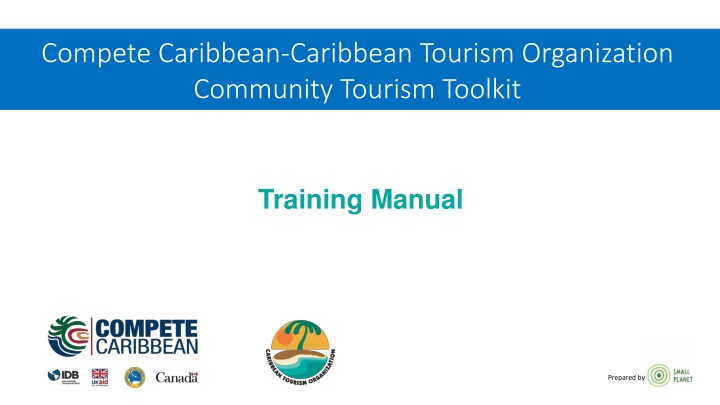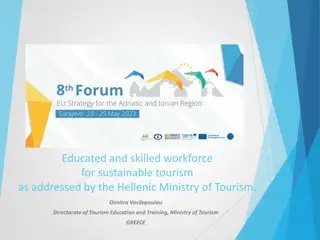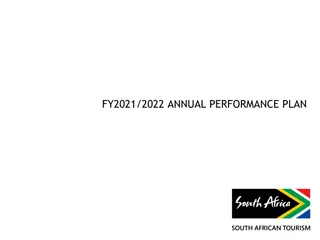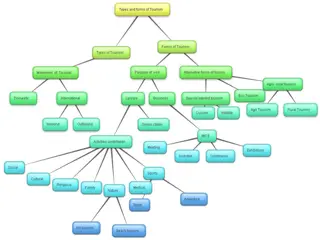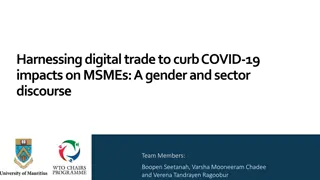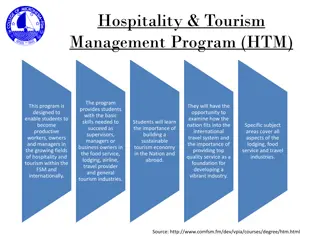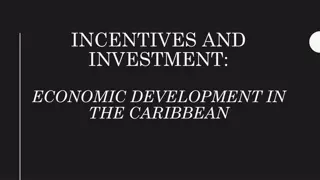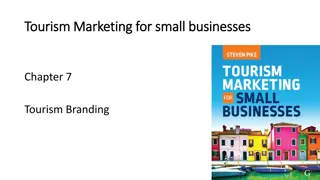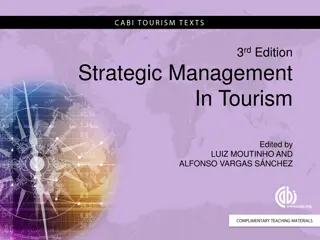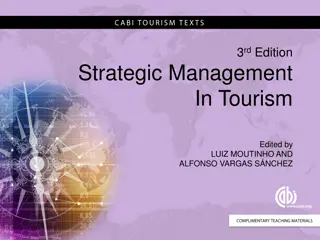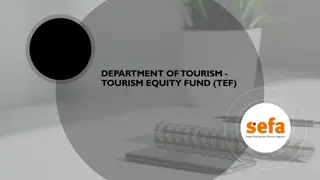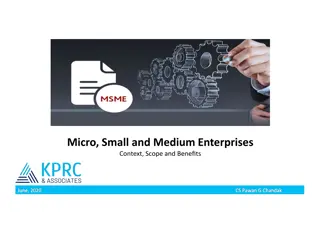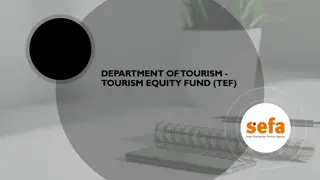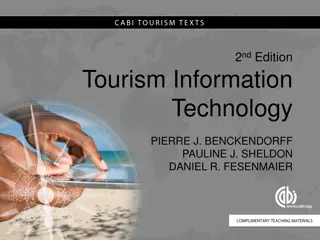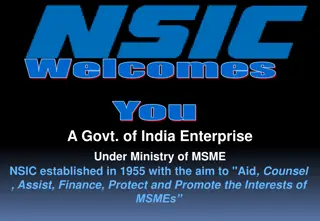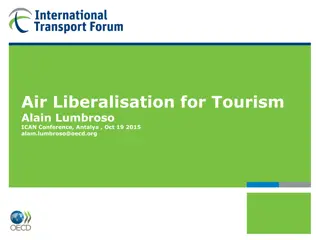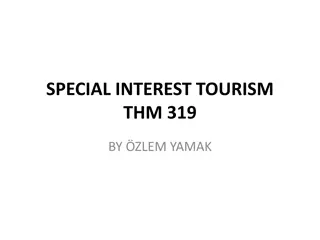Community-Based Tourism Toolkit for Caribbean MSMEs
Developed by Compete Caribbean and the Caribbean Tourism Organization, this toolkit aims to enhance the capacity of Caribbean MSMEs to establish, operate, and promote community-based tourism experiences. The toolkit includes tools for inventory, diagnostics, profiling, and a comprehensive enterprise handbook. It also introduces the Market Ready Model with four levels of readiness to assist tourism businesses in delivering high-quality experiences and expanding their market reach. The handbook draws inspiration from Indigenous Tourism Canada to support community tourism initiatives in the Caribbean region.
Download Presentation

Please find below an Image/Link to download the presentation.
The content on the website is provided AS IS for your information and personal use only. It may not be sold, licensed, or shared on other websites without obtaining consent from the author.If you encounter any issues during the download, it is possible that the publisher has removed the file from their server.
You are allowed to download the files provided on this website for personal or commercial use, subject to the condition that they are used lawfully. All files are the property of their respective owners.
The content on the website is provided AS IS for your information and personal use only. It may not be sold, licensed, or shared on other websites without obtaining consent from the author.
E N D
Presentation Transcript
Compete Caribbean-Caribbean Tourism Organization Community Tourism Toolkit Training Manual Prepared by
Introduction - Community-Based Tourism Toolkit Background Developed by: Compete Caribbean Partnership Facility (CCPF) and the Caribbean Tourism Organization (CTO) under the Innovation for Tourism Expansion and Diversification project. Prepared by: Small Planet Consulting Inc., Canada. Objective: Build the capacity of the CTO to enable more MSMEs (Micro, Small and Medium Enterprises) to successfully start, operate and market Caribbean CBT experiences 13 CCPF countries: Bahamas, Barbados, Belize, Guyana, Jamaica, Suriname, Trinidad and Tobago, Antigua and Barbuda, Dominica, Grenada, St. Lucia, St. Kitts and Nevis, and St. Vincent and the Grenadines. CCPF Technical Cooperation agreement: Three components, all include strategies for women-owned firms (WOF).
Introduction Toolkit Components 1.Tourism Inventory Tool 2.Community-Based Tourism (CBT) Diagnostic Tool 3.Community-Based Tourism (CBT) Profile Tool 4.Caribbean Community-Based Tourism (CBT) Enterprise Handbook (includes PPT Training Deck, Facilitator s Guide and Learning Activities)
Market Ready Model - Foundation 4 Levels of Readiness Top Level - Export Ready Goal is to help tourism businesses constantly improve Can deliver high-quality, consistent, reliable experiences Have better consumer satisfaction Can market through sales partners like tour operators, travel agents and online travel marketplaces Model conceived in 2006 to support Indigenous Tourism development in Canada Aspects used in many countries in the Caribbean & Latin America including Belize, Chile, Cura ao, Grenada, Guyana, Jamaica, Mexico, Peru
Emerging & Visitor Ready Levels Level 2 Visitor Ready Level 1 - Emerging
Market Ready & Export Ready Levels Level 4 Export Ready Level 3 Market Ready
Give Thanks to Handbooks Based on the Model Indigenous Tourism Canada Community Tourism Caribbean
Community Development: Assets Inventory Asset Types List - Reference for completing sheets: 1) Accommodation, 2) Attractions, 3) Services, 4) Experiences (Tours & Activities) 5) Local Experts 6) Infrastructure 1. Accommodation 2. Attractions - 4 types, multiple sub-types Tourism Asset Inventory Uses: 1. To be able to identify asset strengths, gaps, enhancement, build and protection needs. 2. To support itinerary development 3. To support cluster planning and development. Includes: 1. Instructions 2. Asset Types & Sub-Types Lists for Accommodations, Attractions, Services, Experiences, Local Experts, Infrastructure & Services 3. Inventory Sheet for each type of Asset (6 in total) To list and categorise the products, services and infrastructure in the community used (or potentially used) for tourism. Have an inventory of demand generators, which is what is available in the community to attract visitors and support packaging and promotion of tourism products and services. * Any businesses or assets that visitors might use, see, hear or touch while in the community. * The most important information to record is name, location, and contact person to update the details. Use: 3. Services - 3 types, multiple sub-types 4. Experiences (Tours and Activities) - 3 types, multiple sub- types 2.1 Festivals & Events 1 Accommodations 2.2 Culture & Heritage Attractions Purpose: 2.3 Natural Attractions 2.4 General Attractions 5. Local Experts - 5 types, multiple sub-types 3.1 Food & Beverage 3.2 Shopping & Markets 4.1 Culture & Heritage 4.2 Water-based Adventure 3.3 Transportation 4.3 Land-Based Adventure What to include: 1 bed & breakfast 5.2 Natural and Cultural Heritage agricultural 5.1 Tourism rivertubing / rafting /kayaking archaeological site beach 5.3 Performing Arts 5.4 Visual Arts cafe clothes market air services art/graffiti, etc. boating ATV/quads 2 cabin / lodge / ecolodge Asset components: Seven tabs including the "Asset List" which provides an overview of all categories and types of assets. (1) Accommodations - e.g. homestays, hotels, ecolodge, camping, bed & breakfast. (2) Attractions - Festivals & Events, Culture & Heritage Attractions, Natural Attractions, General Attractions. (3) Services - Food & Beverage, Shopping & Markets, Transportation. (4) Experiences (Tours & Activities) - Culture & Heritage, Water-based Adventure, Land-based Adventure. (5) Local Experts (persons with special knowledge) - Tourism, Cultural Heritage, Natural Heritage, Performing Arts, Visual Arts. (6) Infrastructure - Visitor and community infrastructure important for tourism. How to complete: * Use community and tourism websites, business directories, phone books, bulletin boards, etc. * Identify people in the community who know what is available in the community. * Fill or ask others (such as students) to fill each tab to the best of their knowledge. * Identify someone responsible for maintaining the master file so any changes made are captured centrally. boat captain community farmer architecture actor cave artisan amusement park ethnic restaurant craft market bus services dance canoeing 3 campground cycling cenote (water- filled cave) cultural cook/chef art gallery historian artist aquarium artist fast food restaurant farmers market car rental services educational 4 apartment / villa diving/snorkelling caving food/drink/wine driver artisan facility geologist (rocks) desert dance group casino film maker food tour fish market ferry services food/gastronomy fly fishing hiking tour guide 5 guest house/ inn ornithologist (birds) dancer heritage/history designer cemetery full service restaurant forest observatory produce market route taxi services indigenous housekeeper / cleaner kayaking horseback riding fisher folk 6 homestay music group performing art potter church/temple garden / farm science centre gourmet restaurant souvenir store taxi services health & wellness river rafting / tubing walking natural / alternative healers 7 hostel spa therapist sports food processing musician lake photographer stadium/arena home meal herbal / traditional medicine store other sport fishing mountain biking other 8 hotel storytelling visual art singer great house print maker textile artist (crochet, embroidery, knit, weave) land-based park suspension bridge street stands stand/kiosk Frequently Asked Questions (FAQs): 1 Should non- tourism assets be included in the inventory? museum wildlife viewing 1) Accommodation traditional knowledge scooters Yes because: - Visitors often use a mix community and non-community tourism products and services. - When packaging, community tourism businesses often work with non-community businesses to create engaging experiences and provide complementary tourism products and services. - Non-community tourism businesses are important marketing partners for community tourism e.g., they may display your promotional materials, recommend you to their guests, or become a reseller of your products. 2 What is capacity? It is the maximum number of people that can stay in an accommodation facility, visit a place or take part in a tour or activity, etc. at one time. The estimate can be provided as a range such as 10-20 visitors per tour. 3 Is it important to complete the full inventory? regularly. singing group Location Type of Name Name of main contact for booking (First & Last name) (Village & street where the accomodation is located) Accommodation (select from drop- drown menu or refer to Asset List) Phone (How people recognize the place, i.e. brand name) Email (XXX-XXX-XXXX) * No. The Tourism Asset Inventory is a tool to collect information about what exists and can be completed over time. * The inventory should be updated every few years. * It is important to know who is responsible for keeping the master inventory and who will update
Community Development: Assets Inventory Tourism Asset Inventory How to complete: Use community and tourism websites, business directories, phone books, bulletin boards, etc. Identify people who know what is available in the community. Fill or ask others (such as students) to fill each tab to the best of their knowledge. Identify someone responsible for maintaining the master file so any changes made are captured centrally. Use: To list and categorise the products, services and infrastructure in the community used (or potentially used) for tourism. Have an inventory of demand generators, which is what is available in the community to attract visitors and support packaging and promotion of tourism products and services. * Any businesses or assets that visitors might use, see, hear or touch while in the community. * The most important information to record is name, location, and contact person to update the details. Purpose: What to include: Asset components: Seven tabs including the "Asset List" which provides an overview of all categories and types of assets. (1) Accommodations - e.g. homestays, hotels, ecolodge, camping, bed & breakfast. (2) Attractions - Festivals & Events, Culture & Heritage Attractions, Natural Attractions, General Attractions. (3) Services - Food & Beverage, Shopping & Markets, Transportation. (4) Experiences (Tours & Activities) - Culture & Heritage, Water-based Adventure, Land-based Adventure. (5) Local Experts (persons with special knowledge) - Tourism, Cultural Heritage, Natural Heritage, Performing Arts, Visual Arts. (6) Infrastructure - Visitor and community infrastructure important for tourism. How to complete: * Use community and tourism websites, business directories, phone books, bulletin boards, etc. * Identify people in the community who know what is available in the community. * Fill or ask others (such as students) to fill each tab to the best of their knowledge. * Identify someone responsible for maintaining the master file so any changes made are captured centrally. Frequently Asked Questions (FAQs): 1 Should non- tourism assets be included in the inventory? Yes because: - Visitors often use a mix community and non-community tourism products and services. - When packaging, community tourism businesses often work with non-community businesses to create engaging experiences and provide complementary tourism products and services. - Non-community tourism businesses are important marketing partners for community tourism e.g., they may display your promotional materials, recommend you to their guests, or become a reseller of your products. 2 What is capacity? It is the maximum number of people that can stay in an accommodation facility, visit a place or take part in a tour or activity, etc. at one time. The estimate can be provided as a range such as 10-20 visitors per tour. 3 Is it important to complete the full inventory? * It is important to know who is responsible for keeping the master inventory and who will update regularly. * No. The Tourism Asset Inventory is a tool to collect information about what exists and can be completed over time. * The inventory should be updated every few years.
Community Development: CBT Diagnostic Compete Caribbean-Caribbean Tourism Organization Community-Based Tourism Readiness Diagnostic: Introduction Uses: 1. Help to assess a community s readiness for CBT development. 2. To identify strengths and gaps. 3. To support cluster planning and development. Includes: 1. Instructions 2. Diagnostic Tool 3. Diagnostic Framework 4. Scoring Interpretation Provides a frame of reference to assess the community s readiness for Community-Based Tourism (CBT) based on key success factors. * Measure community capacity and readiness for CBT development by assessing development-related strengths and weaknesses. * Support planning and implementation of CBT development. * Identify gaps and priorities to include in a project plan and/or funding proposal. *National Tourism Organizations (NTO s) * Business Development Organizations (BDOs) * Donor and development agencies * Community organisations Guidelines on how to optimize the value of this tool: Organize a meeting with business and community leaders interested in CBT development. Go through the list of questions one-by-one to estimate the score for each criterion. Capture comments that are useful to understand the score and what needs to be done to improve the score. Based on the scores, identify the main gaps or areas needing improvement. Prioritize the gaps / areas for improvement. For each priority area for improvement, discuss the actions needed. For each action, identify key actions needed and who can be responsible for addressing the action. Identify other immediate next steps needed to support CBT tourism development. Establish processes for moving forward on actions and reporting progress to goals. Periodically revisit and update the diagnostic tool to monitor and evaluate progress, with the aim of continuous improvement. development plans? 1.4 Independent AdministrationDoes the community have established administrative and financial systems and procedures specifically for developing and managing CBT (e.g., separate accounting systems and bank accounts used only for CBT development, CBT funds not subject to appropriation for other uses)? Diagnostic tool: Purposes: Users: Process: Compete Caribbean-Caribbean Tourism Organization Community-Based Tourism Readiness Diagnostic - Success Factors Criteria and Scoring Step 1 Step 2 Step 3 Step 4 Step 5 Step 6 Step 7 Step 8 Step 9 Step 10 Key CBT success factors Assign a score based on best estimate of the extent to which the community meets each criterion Meets 2 points Partially meets 1 point Does not Meet 0 point 1Governance and Leadership 1.1 CBT integrated in local economic planning Is Community Based Tourism CBT part of a broader community development plan? Does the community prioritize CBT as a development strategy? Does the community have a written CBT development strategy or plan? Has zoning been done to designate areas in the community to be used for tourism? Is there a management committee (or group) responsible for CBT? Does the CBT committee involve women? Is the CBT committee representative of community members (e.g., youth, elderly, farmers, fishers, as relevant to the community)? Does the community have strong partnerships with government, NGOs or other agencies that support the community's CBT 1.2 Representative governance 1.3 Partnerships Section Subtotal: 0 0 0
Governance and Leadership CBT integrated in local economic planning Representative governance Partnerships Independent administration Community Participation Community interest Knowledgeable community members Community consultation and engagement Protocols for visitors Access to Resources Access to land Protected CBT assets Access to business support services Access to finance Access to capital investments Access to technical training Infrastructure & Services Accessibility Basic infrastructure (water, waste, electrical, communication and financial services) Health and medical Security Human Resources Management skills Operational skills Licenses and credentials Tourism Assets Asset inventory Signage Retail/shops Product Development and Marketing Market research Product base Marketing Industry linkages Factors 4 3 1 1 CBT Diagnostic 2 2 3 1 1 1 1 1 1 1 Key Dimensions & Success Factors: Seven (7) Key Dimensions 56 Success Factors 2 7 1 1 5 1 1 8 1 1 1 1 1 2 56 TOTAL
Community Development: CBT Diagnostic CBT Readiness Assessment Scorecard Maximum Category Score Score to be CBT capable (45%) Score to be CBT ready (60%) Category Scoring: Three (3) scoring levels Maximum score of 112 Governance & Leadership (9 factors) 18 9 14 Community Participation (8 factors) 16 8 12 Access to Resources (6 factors) 12 6 8 Infrastructure & Services (11 factors) 22 11 17 Meets 2 points Partially meets 1 point Does not Meet 0 point Human Resources (7 factors) 14 7 7 Tourism Assets (10 factors) 20 5 5 Product Development & Marketing (5 factors) 10 5 5 TOTALS 112 51 68
Community Development: CBT Diagnostic CBT Readiness Assessment Scorecard Notes for CBT capable: 50% minimum score for first four categories because they are foundations for success in any economic development. 50% score for HR because we included management level questions, which many communities would not meet. 25% score for tourism assets because 8 of the 10 factors are related to the assets inventory. 50% score for PD and marketing because a product base and linkages are the main success factors. Maximum Category Score Score to be CBT capable (45%) Score to be CBT ready (60%) Category Governance & Leadership (9 factors) 18 9 14 Community Participation (8 factors) 16 8 12 Access to Resources (6 factors) 12 6 8 Infrastructure & Services (11 factors) 22 11 17 Notes for CBT ready: 75% minimum score for first four categories because they are foundations for success in any economic development. 50% score for HR because we included management level questions, which many communities would not meet. 25% score for tourism assets because 8 of the 12 factors are related to the assets inventory. 50% score for PD and marketing because a product base and linkages are the main factors. Human Resources (7 factors) 14 7 7 Tourism Assets (10 factors) 20 5 5 Product Development & Marketing (5 factors) 10 5 5 TOTALS 112 51 68
Community Development: CBT Diagnostic How to Complete: Step 1 Organize a meeting with business and community leaders interested in CBT development. Step 2 Go through the list of questions one-by-one to estimate the score for each criterion. Step 3 Capture comments that are useful to understand the score and what needs to be done to improve the score. Step 4 Based on the scores, identify the main gaps or areas needing improvement. Step 5 Prioritize the gaps / areas for improvement. Step 6 discuss the actions needed. Step 7 For each action, identify key actions needed and who can be responsible for addressing the action. Step 8 Identify other immediate next steps needed to support CBT tourism development. Step 9 Establish processes for moving forward on actions and reporting progress to goals. Step 10 Periodically revisit and update the diagnostic tool to monitor and evaluate progress, with the aim of continuous improvement. For each priority area for improvement,
Market Development Tools: CBT Profile Uses: 1. Promoting communities to visitors e.g., to prepare website or brochure. 2. CTO can develop a database and promote to visitors. Includes: 1. Instructions. 2. Community Profile overview information about the community, CBT experiences, products and services. 3. See, Do & Stay CBT enterprises directory & visitor information. How to Complete: 1. Use the Tourism Assets Inventory and other research. 2. 10 sample profiles prepared by CTO.
Enterprise Development Tools: CBT Handbook Uses: 1. Training of CBT business owners, manager and staff. 2. Classroom or one-to-one training. Includes: 1. Caribbean CBT Enterprise Handbook (pdf) 2. CBT Business Directories (12 CCPF countries only) (pdf) 3. Facilitator s Tools: i. Training Presentation Deck (PowerPoint) ii. Facilitator s Guide (word) iii. Learning Activity Handouts (3) (word)
Enterprise Development Tools: CBT Handbook 5.0 Understanding Your Markets 5.1 What is Market-Driven Research? 5.2 Which Types of Visitors Have the Most Potential? 5.3 Who is my Ideal Guest? 6.0 Developing Your Product 6.1 What is Packaging? 6.2 What Types of CBT Packages Do Visitors Buy? 6.3 What are the Essential Qualities of a CBT Product? 6.4 What Product Can I Offer? 6.5 What are the Steps in Product Development? 7.0 Pricing Your Product 7.1 How Does the Travel Distribution System Work? 7.2 What Commissions Do the Travel Trade Expect? 7.3 What are Net and Retail Rates? 7.4 How Do I Calculate My Net Rate? 7.5 How Do I Calculate My Retail Rate? 8.0 Meeting Visitor Expectations 8.1 What is Values-Based Guest Hospitality? 8.2 How Can I Create a Sense of Place? 8.3 What is Genuine Hosting? 8.4 How Should I Prepare Guests for Their Visit? 8.5 How Can I Learn from Feedback? 9.0 Marketing Your Product 9.1 What are the 4 Ps of Marketing? 9.2 What Goes into a Marketing Plan? 9.3 Why is Branding Important? 9.4 How Do I Make a Marketing Content Library? 9.5 Why is Online Marketing Important? 9.6 What are the Best Ways to Market? 10.0 Developing Financial Management Skills 10.1 Why Do I Need Financial Management? 10.2 How Do I Estimate My Start-up Costs? 10.3 How Do I Prepare an Annual Operating Budget 10.4 How Will I Finance My Business? 10.5 What are the Essential Financial Statements? 10.6 What about Taxation and Reporting? 10.7 Why Should I Get Professional Assistance? 10.8 Checklist for Financial Success 11.0 Building Your Support Network 11.1 Building Your Support Network 1.0 The Global Travel Industry 1.1 Many Different Parts 1.2 The Global Scene 1.3 Impacts of Tourism 1.4 Global Tourism Trends 2.0 Understanding CBT 2.1 What is Community-Based Tourism (CBT)? 2.2 What are the Benefits and Drawbacks of CBT? 2.3 Community-Based Tourism in the Caribbean Types of CBT Experiences in the Caribbean: 2019 3.0 Protecting & Involving Your Community 3.1 What is Cultural Authenticity? 3.2 How Can You Protect and Benefit Your Community? 4.0 Planning your CBT Business 4.1 What is a Market Ready Tourism Business? 4.2 What are the Steps to Starting a CBT Business? 4.3 What Goes into a Business Plan? 4.4 Where Can I Get Help for My Business Plan? Glossary Appendix 1: References and Resources Appendix 2: NTOs and CBT Development Appendix 3: Experience Development Template Appendix 4: Example Code of Conduct
Enterprise Development Tools: CBT Handbook Facilitator Tools to Support Delivery of CBT Handbook Training How to Use for Training: 1. Follow facilitator tools sequenced to the sections of the CBT Handbook. 2. PPT Presentation Deck use with LCD, HDMI or portable presentation monitors. 3. Facilitator Guide provides tips, schedules, checklists and detailed notes for delivering a workshop using the tools. 4. Learning Activities to deepen understanding of the content and use of the Handbook. 10: Developing Financial Management Skills
Thank you! Prepared by
